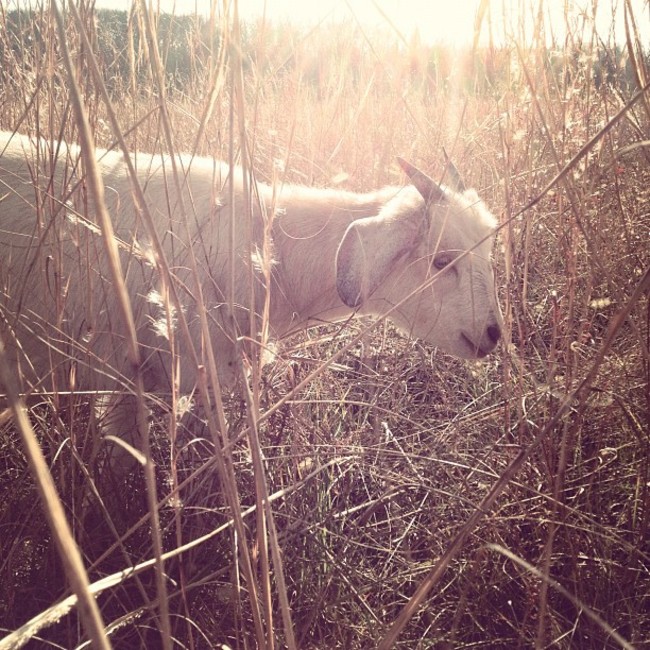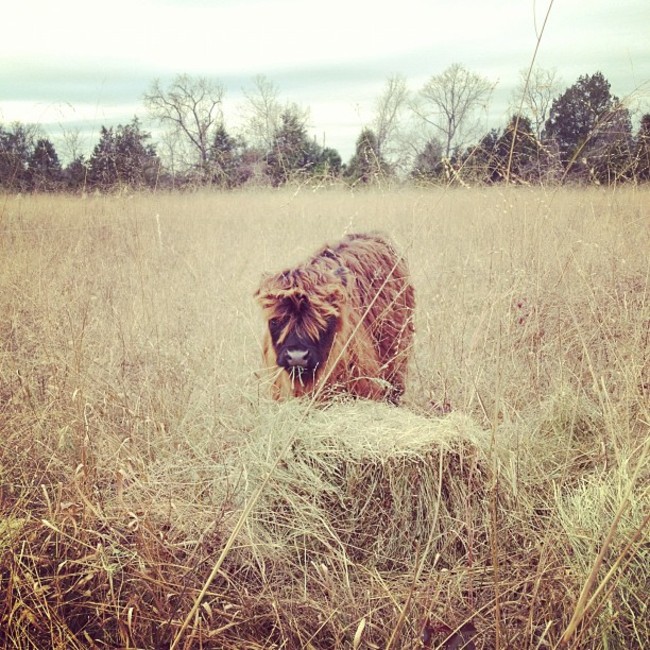 Willow grazing on a sunny November morning This is our first winter on the farm and the shift in seasons has posed a lot of new hurdles, including the grazing situation.
Willow grazing on a sunny November morning This is our first winter on the farm and the shift in seasons has posed a lot of new hurdles, including the grazing situation.
Over the past few weeks the pastures have slowly transitioned from bright, green grass to a brown, stemmy, seedy mess. The cows tend to seek out the green stuff, buried below the dead grass. The goats seek out cold-hardy “weeds”, such as rose, privet, cedar, and other small bushes/saplings. Both the cows and the goats are eating through their paddocks about two or three times as fast as in the summer. There's less available forage in each particular paddock and the animals need to eat more since they're burning more calories staying warm in the cold weather.
The rapid pasture consumption brings up the dilemma of rotating them through the pastures faster or slower. There's not as much good forage in the same amount of area, so you would think that rotating the animals more quickly would be the best idea. Generally, however, I would say that slowing down the rotation would be the best idea, if possible. You push the animals to get more out of each paddock and you also give the other paddocks a longer rest period. In the winter (and other slow growth periods) you want to increase the rest periods to encourage better regrowth and reduce pressure on the forage base. That's not a hard and fast rule, everyone has their own unique circumstances.
For instance, we have a small goat herd this year and lots of pasture that hasn’t been grazed in a long time, so I’ve been increasing the rate of rotation and waiting to feed hay. So far the goats are doing very well and we haven’t fed any hay on pasture. Depending on the weather I think we might be able to go close to the whole winter without bringing the goats hay. Another reason to rotate dairy goats more quickly is because you can't push them as hard as meat animals (i.e. beef cows or meat goats). The meat animals can be pushed to "do a job" on the pasture. The dairy animals have higher nutritional requirements (particularly during lactation), so keeping them on fresh pasture is almost always the optimal solution. That means I am moving the goats at least every other day (sometimes every day), whereas in the spring/summer I might go 5-7 days.
The cows are the opposite. I am intentionally slowing down their rotation for the reasons listed above. I want them to graze harder than they are. We have stock-piled forages that they will eat, they just need some time. The goats will wipe out everything in sight (except broomsedge). The cows seem a little pickier and need a little coercion. Because of this, the cows are getting some hay. I’m particularly conscious of the cows’ health because Janis (the momma) is at 3-4 months lactation.
Once we get closer to the carrying capacity of our land it’s going to take a much different land-management style. I'll also have a better idea for which types of forages we can introduce to improve year-round grazing environment. This first year I just wanted to wrap my head around what we were starting with. Over the years we'll try to balance our current diversity with meeting the nutritional needs of the animals in every season. I enjoy thinking about the differences when I’m out fencing in the cold, keeps the brain busy.
Also, another tip, it’s much easier moving the fencing AFTER the frost has burned off, unless of course you like soaking wet blue jeans on cold November mornings.



Back to News